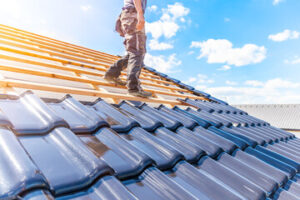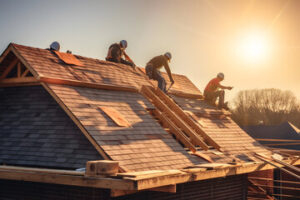Roofing Louisiana installation is a big project that affects the safety and value of your home. It involves many elements, from selecting the right materials to determining what steps will be taken to protect your property.

First, roofers prepare the area around your roof by covering it with tarps and putting down wooden boards to cover things like the garden or air conditioning unit. Then they lay ice and water protection, followed by underlayment.
Roofing materials can make or break the success of a roof installation project. You must choose a material that is durable, affordable and easy to maintain. In addition, it should fit the aesthetic of your home and meet the environmental requirements of your area. There are several types of roofing materials to choose from, including asphalt shingles, wood shakes, and standing seam metal roofs.
An asphalt shingle is the classic choice for most homes. It’s durable, affordable and comes in many different colors and styles to suit any house. In addition, it is easy to repair and replace if necessary. Wood shakes and shingles made from natural cedar have a warm, rustic look that suits both traditional and modern styles. However, these roofs require regular maintenance to prevent leaks and fires. They may also be restricted in areas prone to wildfires.
Metal roofs can be long-lasting, durable and energy efficient. They’re available in a wide variety of colors and styles, including corrugated metal panels, shingles, and standing seam metal roofs. They’re a popular option for homeowners in areas prone to wildfires and hail damage. In addition, they can be insulated for added energy efficiency.
Clay tiles are another type of durable roofing material. They add a beautiful, classic look to a home and can last upwards of 50 years. But they’re also heavy, which can cause structural issues in older homes. Concrete tile is an alternative that’s lighter and can mimic other roofing materials. It’s also durable and has a lifespan of more than 100 years.
To protect the deck of your roof, you’ll need underlayment to lay before putting down your roofing materials. This layer prevents water from permeating the roof and causing rot or attic leaks. Underlayment is typically made of felt or synthetic material. Felt underlayment is available in 15 or 30 lb. rolls, while synthetic underlayment is more resilient and doesn’t tear as easily.
In addition to your roofing materials, you’ll need tools to complete the job. A caulking gun is ideal for distributing the adhesive, and a pair of tin snips will make cutting flashing and gutter materials much easier. You’ll also need galvanized nails for your roof, which will keep them resistant to rust.
Permits
Roofing permits are necessary to ensure that your home’s roof is installed in accordance with local building codes. This helps to ensure the safety of occupants and the integrity of the structure. It also helps to protect the value of your home and makes it more attractive to potential buyers.
The exact rules on when you need a permit for a roofing project can vary, but most cities and states require them for any work that is structural. This includes anything from a minor repair to replacing the entire roof. It can also include things like removing or moving vents, adding insulation, and changing the roof’s pitch. If you have a new roof, you may need to submit plans of the installation and request inspections during construction to make sure the work is up to code.
While the process of getting a permit can seem like an inconvenience, it is important to follow the regulations in your area. By taking the time to find a qualified roofer and ensuring that the permit is in place, you can be sure that your roof will meet or exceed all required standards for safety and durability.
It is also worth noting that if you do complete a re-roofing project without a permit, the change to your home will be caught during the next appraisal or when you attempt to sell the house. This can lead to expensive corrections and delays. It may also make your mortgage lender more wary about approving a loan for the property.
If you are working with a residential roofing contractor, they should handle the permit process on your behalf. In addition, many roof manufacturers require that the roofing installation be performed in compliance with all applicable building codes to ensure the validity of their warranties.
There are several different types of roofing permits, ranging from the EZ Re-Roofing Permit to a full building permit. The EZ Re-Roofing permit is intended for homeowners and is typically available online or over the phone. It covers everything from the tear-off and overlay portions of a re-roofing job to the gutters and flashing.
Safety
When it comes to roofing installation, safety is paramount. Ladders, scaffolding and other equipment are all dangerous, and the wrong technique can lead to injuries or even death. Proper training and maintenance is essential. It is also important to have a culture of safety, with all workers following established procedures and reporting any safety concerns immediately.
Ladders are the main cause of serious falls during roofing. Always inspect ladders before use, and never use one that’s damaged or overloaded. It is also important to check for overhead power lines before climbing. Always follow ladder manufacturer guidelines and OSHA safety standards. For roofs that are too steep for ladders, it’s advisable to have a contractor use a boom lift or other elevated work platform.
Ensure that all workers have the proper personal protective equipment, including hard hats, safety goggles, gloves and slip-resistant footwear. Provide regular safety meetings and encourage crews to stay informed of current OSHA safety regulations.
Create a detailed plan for each phase of the project and identify potential hazards. Consider bringing a safety monitor onto the roof to oversee work and make sure everyone is on safe walkways. It’s also a good idea to have the contractor install perimeter warning lines on the roof to prevent people from walking too close to the edge.
In winter, it’s vital to have a solid snow and ice removal plan for the job site. Instruct workers to wear adequate winter clothing and take extra time on the job to avoid rushing. This will keep workers comfortable and decrease the risk of falling or getting injured.
In addition to safety measures, all roofing professionals should be trained in the proper use of the tools and equipment required for their jobs. This includes using nail guns safely, as well as understanding basic first aid techniques. A lack of appropriate training is often what gets construction companies into hot water with OSHA. In the case of roofing, this can result in heavy fines for violations involving fall protection, unsafe ladders and other hazardous conditions. OSHA training can help ensure that all roofing professionals are trained in the correct way to operate and maintain all equipment involved in a roof repair or installation.
Timeline
Roofing projects are time-consuming and require meticulous planning. Many factors affect the timeframe for a roof installation, including material selection, preparation, and actual roofing. Having a good understanding of the process can help homeowners and property managers determine what kind of timeline they should expect.
The first stage of a roofing project is the pre-installation phase, which includes protecting landscaping and adjacent areas, setting up scaffolding, and preparing the roof surface. It also includes removing old roofing materials and installing any needed structural repairs. Depending on the complexity of the roof and the chosen materials, this phase can take anywhere from several days to a week.
Once the preparatory work is complete, the crew can begin working on the actual roof installation. This is typically done in stages, requiring the crew to climb up and down multiple times throughout the day to dispose of materials and grab new ones. If there is any unforeseen problems during the process, this can also increase the timeframe as the team will have to stop what they are doing and come up with a solution.
A common issue that can slow down the installation process is weather conditions. Inclement weather makes it unsafe for the crew to be on the roof and can delay the entire project. In addition, it can make it difficult to lay down the materials and may lead to leaks.
Other factors that can affect the roofing installation timeline are material availability and scheduling conflicts or delays. It can also take more time to obtain permits and schedule inspections than expected.
Lastly, the experience and efficiency of the roofing crew can play a big role in how long the project takes to complete. A highly skilled and efficient team can work much faster than a less-experienced crew.

